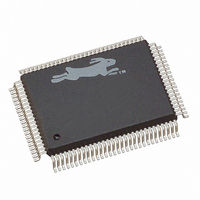20-668-0003 Rabbit Semiconductor, 20-668-0003 Datasheet - Page 95

20-668-0003
Manufacturer Part Number
20-668-0003
Description
IC CPU RABBIT2000 30MHZ 100PQFP
Manufacturer
Rabbit Semiconductor
Datasheet
1.20-668-0003.pdf
(228 pages)
Specifications of 20-668-0003
Processor Type
Rabbit 2000 8-Bit
Speed
30MHz
Voltage
2.7V, 3V, 3.3V, 5V
Mounting Type
Surface Mount
Package / Case
100-MQFP, 100-PQFP
Data Bus Width
8 bit
Maximum Clock Frequency
30 MHz
Operating Supply Voltage
0 V to 5.5 V
Maximum Operating Temperature
+ 85 C
Mounting Style
SMD/SMT
Minimum Operating Temperature
- 40 C
Number Of Programmable I/os
40
Number Of Timers
8 & 10 bit
Lead Free Status / RoHS Status
Lead free / RoHS Compliant
Features
-
Lead Free Status / Rohs Status
Lead free / RoHS Compliant
Other names
20-668-0003
316-1062
316-1062
Available stocks
Company
Part Number
Manufacturer
Quantity
Price
Company:
Part Number:
20-668-0003
Manufacturer:
Rabbit Semiconductor
Quantity:
10 000
- Current page: 95 of 228
- Download datasheet (2Mb)
Serial Port A is selected for bootstrap operation as a clocked serial port when SMODE =
10. In this case bit 7 of Parallel Port C is used for the serial data and bit 1 of Parallel Port B
is used for the serial clock. Note that the serial clock must be externally supplied for boot-
strap operation. This precludes the use of a serial EEPROM for bootstrap operation.
Serial Port A is selected for bootstrap operation as an asynchronous serial port when
SMODE = 11. In this case bit 7 of Parallel Port C is used for the serial data and the 32 kHz
oscillator is used to provide the serial clock. A dedicated divide circuit allows the use of
the 32 kHz signal to provide the timing reference for the 2400 bps asynchronous transfer.
Only 2400 bps is supported for bootstrap operation, and the serial data must be eight bits
for proper operation.
When the first phase of a bootstrap is performed using Serial Port A, the TXA signal is not
needed since the bootstrap is a one-way communication. After the reset ends and the boot-
strap mode begins, TXA will be low, reflecting its function as a parallel port output bit that
is cleared by the reset. This may be interpreted as a break signal by some serial communi-
cation devices. TXA can be forced high by sending the triplet 0x80, 0x50, 0x40, which
stores 0x40 in parallel port C. An alternate approach is to send the triplet 0x80, 0x55,
0x40, which will enable the TXA output from bit 6 of parallel port C by writing to the par-
allel port C function register (0x55).
The transfer rate in any bootstrap operation must not be too fast for the processor to exe-
cute the instruction stream. The Write Empty signal acts as an interlock when using the
Slave Port for bootstrap operation, because the next byte should not be written to the Slave
Port until the Write Empty signal is active. No such interlock exists for the clocked serial
and asynchronous bootstrap operation. In these cases, remember that the processor clock
starts out in divide-by-eight mode with four wait states, and limit the transfer rate accord-
ingly. In asynchronous mode at 2400 bps it takes about 4 ms to send each character, so no
problem is likely unless the system clock is extremely slow.
Chapter 7 Miscellaneous I/O Functions
NOTE:
procedure, sending the “byte triplets,” two-way communication is required once
the cold loader has been loaded.
Although the TXA signal is not needed during the first phase of the boot
89
Related parts for 20-668-0003
Image
Part Number
Description
Manufacturer
Datasheet
Request
R

Part Number:
Description:
IC CPU RABBIT4000 128-LQFP
Manufacturer:
Rabbit Semiconductor
Datasheet:

Part Number:
Description:
IC MPU RABIT3000A 55.5MHZ128LQFP
Manufacturer:
Rabbit Semiconductor
Datasheet:

Part Number:
Description:
Microprocessors - MPU Rabbit 3000 TFBGA Microprocessor
Manufacturer:
Rabbit Semiconductor

Part Number:
Description:
Microprocessors - MPU Rabbit 4000 LQFP Microprocessor
Manufacturer:
Rabbit Semiconductor

Part Number:
Description:
IC, I/O EXPANDER, 8BIT, 40MHZ, TQFP-64
Manufacturer:
Rabbit Semiconductor

Part Number:
Description:
SCRs 1.5A 200uA 400V Sensing
Manufacturer:
Littelfuse Inc
Datasheet:

Part Number:
Description:
CARD 6-RELAY SMARTSTAR SR9500
Manufacturer:
Rabbit Semiconductor
Datasheet:

Part Number:
Description:
WIRE-BOARD CONN RECEPTACLE, 6POS, 3.96MM
Manufacturer:
TE Connectivity
Datasheet:

Part Number:
Description:
ADAPTER 20 PIN .420" PLUGS(6PCS)
Manufacturer:
Logical Systems Inc.
Datasheet:

Part Number:
Description:
CONN BARRIER BLOCK .438" 20 POS
Manufacturer:
Cinch Connectors
Datasheet:

Part Number:
Description:
20 MODII 2PC HDR DR SHRD, ROHS
Manufacturer:
TE Connectivity
Datasheet:

Part Number:
Description:
WIRE-BOARD CONN RECEPTACLE, 6POS, 3.96MM
Manufacturer:
TE Connectivity
Datasheet:














